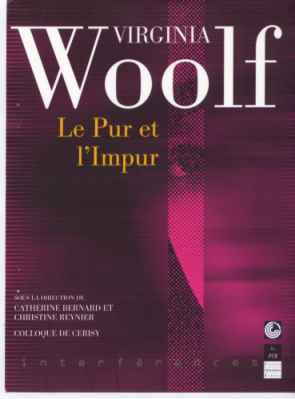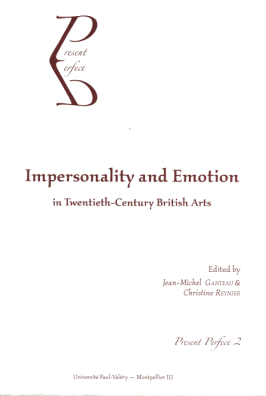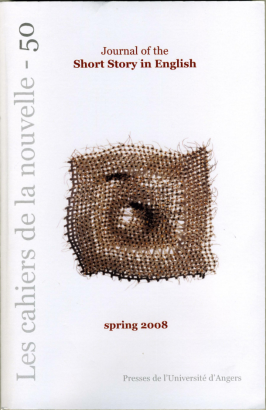CHRISTINE REYNIER
Ancienne élève de l'Ecole Normale Supérieure de Fontenay-aux-roses, agrégée d'anglais, docteur d'Etat, Christine Reynier est professeur de littérature britannique à l'Université Montpellier III et présidente de la SEAC.

Reynier, Christine, Bernard, Catherine (ed.), Virginia Woolf. Le Pur et l'impur (Colloque de Cerisy 2001), Rennes: Presses Universitaires de Rennes, Collection Interférences, 2002.
Le
rôle
majeur
joué
par
Virginia
Woolf
dans
la
littérature
anglaise
des
années
vingt
et
trente
n'est
plus à
démontrer.
On
sait
combien
Mrs
Dalloway,
La
Promenade
au
Phare,
Les
Vagues,
contribuèrent
à
faire
émerger
une
écriture
de la
modernité,
une
langue
mouvante,
labile,
suspendue
à la
frontière
de la
prose
et de
la
poésie,
lovée
au
plus
intime
de la
conscience.
Dans
l'ombre
de ces
romans,
le
reste
de son
œuvre
foisonnante
reste
encore
mal
connu.
Les
écrits
politiques
de
Woolf,
ses
nouvelles,
ses
essais,
sa
correspondance
permettent
cependant
de
voir
un
imaginaire
littéraire
et
politique
à
l'œuvre.
De
même,
alors
que la
critique
tendit
précédemment
à
privilégier
les
enjeux
formels
et
phénoménologiques
de
l'écriture
poétique
de
Woolf,
des
études
récentes
ont
exploré
ses
liens
avec
son
contexte
épistémologique
et
politique,
les
échos
intertextuels
ou
inter-esthétiques
qui
s'y
font
entendre.
Le
volume
d'articles
réunis
ici se
propose
de
faire
le
point
sur
ces
perspectives
formelles
et
théoriques.
Il est
le
fruit
des
travaux
du
Colloque
de
Cerisy
qui se
tint
en
2001
sur
l'œuvre
de la
romancière.
En
choisissant
d'interroger
les
notions
de
"pur"
et
d'"impur"
-
notions
qui
font
souvent
retour
sous
la
plume
de la
romancière
- les
auteurs
proposent
d'ouvrir
un
dialogue
entre
les
textes
les
plus
canoniques
et le
reste
de
l'œuvre
jugé
longtemps
mineur
ou
"impur",
mais
aussi
entre
des
approches
critiques
multiples
(génétique,
psychanalyse,
épistémologie...),
toutes
mises
au
défi
par un
univers
littéraire
paradoxal
qui
résiste
à la
synthèse
et à
la
clôture.
As the readers familiar with Julian Barnes's Flaubert's Parrot will know, Gustave Flaubert, who believed in the impersonality of the work o f art, is the object of the quest o f Barnes's character. Under the guise o f looking for Flaubert's parrot, supposed to have inspired "Un Coeur simple;" Braithwaite is trying both to probe the nature of writing (is it representational or not?) and to understand Flaubert's "nature;" i.e. the genuine self of the writer, in a fictional autobiography that would be more reliable than an ordinary one. Flaubert thus finds himself at the core o f a paradoxical enterprise which finally reflects his own paradoxical belief in a personal impersonality: "L'artiste, clans son oeuvre, doit être comme Dieu clans l'univers, present partout et visible nulle part." Such a belief leads him to write most movingly about emotions in, for example, "Un Coeur simple" and turns him into the object o f the most emotional quest o f Braithwaite, the autodiegetic narrator of Flaubert's Parrot. |

Cahiers
Victoriens
et
Edouardiens
62
(octobre
2005)
Insights
into
the
Legacy
of
Bloomsbury
With
unpublished
essays
and
memoirs
by
Roger
Fry,
Vanessa
Bell
and
Virginia
Woolf
Edited,
with
an
introduction,
by
Christine
Reynier
Université
Montpellier
III
2005,
format
15 ×
21,
240
pages,
ISBN
2-84269-701-4
Prix
de
vente
:15
euros
(publications@univ-montp3.fr
http://alor.univ-montp3.fr/serpub)
http://publications.univ-montp3.fr/cve-62
![]()

Impersonality and Emotion in Twentieth-Century British Arts, eds. Jean-Michel Ganteau & Christine Reynier. Montpellier: Presses Universitaires de Montpellier III, Present Perfect 2, 2006. ISBN 2-84269-751-0. 15 euros.
This volume comes as a sequel to a previous publication, Impersonality and Emotion in Twentieth-Century British Literature, which explored the paradoxical connections between impersonality and emotion, two notions central to modernist as well as to later British literature. Through the double prism of impersonality and emotion, the first set of articles presented here bring to light if not the tenets of Modernism, at least some of the aesthetic principles of representative artists of the time and, from Beardsley to Hitchcock through Windham Lewis, Gaudier Brzeska and Epstein, browses through various forms like drawing, architecture, film and the radio play. The second half of the volume concentrates on the post-war period, addressing the vexed question of the relationships between impersonality and emotion in film (Antonioni), drama (Bond), photography (Brandt, Almond), painting (School of London), architecture, and other types of contemporary manifestations and installations practised by the Young British Artists and their contemporaries (Hirst, Taylor-Wood, Floyer, Whiteread, Opie among others). The twenty two articles in this collection unearth lines of force that run all the way from romanticism to postmodernism. While stressing the unexpected perenniality of the impersonal, they give the lie to Fredric Jameson’s famous vision of contemporary literature as characterised by a “waning of affect”.

Journal of the Short Story in English, Special Issue on Virginia Woolf, ed. Christine Reynier, 50 (July 2008)
CONTENTS
Christine Reynier—The “obstinate resistance” of Woolf's Short Story. 11-16
Part ONE
the short story commitments
Elke D'Hoker—The Role of Imagination in Virginia Woolf's Short Fiction.
17-31
Charles Sumner—Beauty and Damaged Life in Virginia Woolf's Short Fiction.
33-47
Kate Henderson—Fashioning
Anti-Semitism: Virginia Woolf's “The Duchess and the Jeweller” and the
Readers of Harper's Bazaar. 49-65
Anne Besnault-Levita—Speech-Acts,
Represented Thoughts and Human Intercourse in “The Introduction” and
“Together and Apart”. 67-83
Ann McClellan—Adeline's
(Bankrupt) Education Fund: Woolf, Women, and Education in the Short Fiction.
85-101
Leena Kore Schröder—Who's
Afraid of Rosamond Merridew?: Reading Medieval History in “The Journal of
Mistress Joan Martyn”. 103-119
Part Two
Beyond Experimentalism: Genetics, philosophy, science and the short story
Oliver
Taylor—“What's 'it'-What do you mean by 'it'?”: Lost Readings and Getting
Lost in “Kew Gardens”. 121-135
Frank Stevenson—Enclosing the Whole: Woolf's “Kew Gardens” as Autopoietic
Narrative. 137-152
Laura Marcus—“In the Circle of the Lens”: Woolf's “Telescope” Story,
Scene-Making and Memory. 153-169
Teresa Prudente—“To slip easily from one thing to another”: Experimentalism
and Perception in Woolf's Short Stories.171-183
Part Three
Music, Painting, Cinema and the short story
Liliane Louvel—Telling
“by” Pictures: Virginia Woolf's Shorter Fiction.185-200
Emilie Crapoulet—Beyond
the Boundaries of Language: Music in Virginia Woolf's “The String Quartet”.
201-215
Abbie Garrington—Reflections
on a Cinematic Story. 217-226
Abstracts
Contributors' Notes